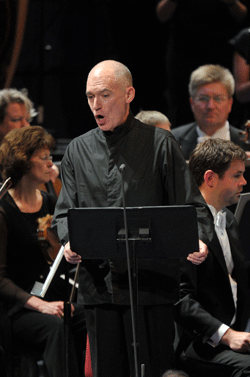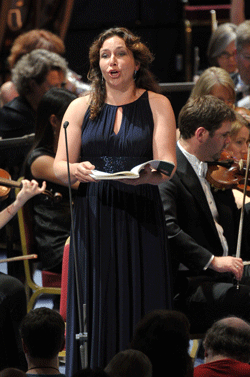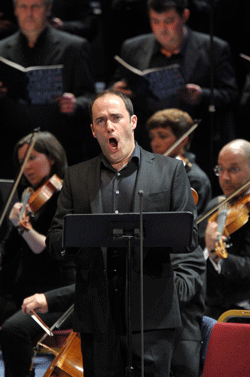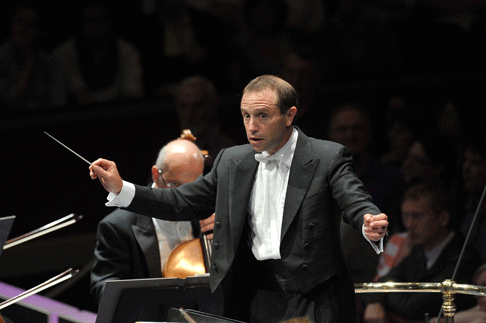19 Aug 2011
BBC Prom 41
This concert of three substantial choral and orchestral works by Benjamin Britten recreated the ‘50th birthday’ Promenade concert which Britten himself conducted on 12 September 1963.

This concert of three substantial choral and orchestral works by Benjamin Britten recreated the ‘50th birthday’ Promenade concert which Britten himself conducted on 12 September 1963.
Commissions from the Japanese government and Serge Koussevitsky had resulted in the Sinfonia da Requiem (1940) and Spring Symphony (1949) respectively; now added to these earlier works was a new composition, the Cantata Misericordium commissioned for the centenary of the International Red Cross, and first heard at their celebrations in Geneva just a few days earlier.
 Alan Oke
Alan Oke
It was Ronald Duncan, the librettist of the Rape of Lucretia, who once remarked that Britten had told him that “he never had a purely musical thought unrelated to a verbal context”*. Certainly, the absence of a ‘straightforward’ symphony from Britten’s oeuvre might suggest that he was not naturally inclined towards ‘pure’ symphonic structures and approaches. However, this performance by the BBC Symphony Orchestra was conducted with conviction and insight by Mark Wigglesworth (deputising for an indisposed Jiři Bělohlávek), and his superb crafting of the complex and at times problematic architecture of these works revealed the composer’s control of symphonic form and mastery of instrumental colour.
The Cantata Misericordium relates the New Testament story of the Good Samaritan, the chorus framing and commenting on the action as presented by two soloists — a Traveller (baritone) and Samaritan (tenor). The text is wholly in Latin and this lends an air of formality which both the BBC Singers and the excellent soloists, Leigh Melrose and Alan Oke, sustained without becoming overly stylised or austere. Indeed, the soloists’ drama was earnestly related, building to a moving climax during the attack upon the Traveller which culminated in an intense, chromatic choral outburst.
 Christine Rice
Christine Rice
Wigglesworth handled the continuous form, with its clearly delineated sections, with great skill, subtly controlling the rhythmic tensions which establish a forward-moving pulse. He fashioned a coherent narrative which moved from the tightly-controlled motivic statements of the instrumental introduction (drawing beautifully tender playing from the solo string quartet), to a more expansive close, the rich concordant harmonies of the full orchestra suggesting relaxation and reconciliation.
Wigglesworth revealed a similar appreciation of form in the Sinfonia da Requiem commissioned to celebrate the 2,600th anniversary of the Japanese empire, but ultimately declared unsuitable, its sentiments considered insufficiently triumphant, overly religious and inappropriately Christian in nature. The three movements — Lacrymosa, Dies Irae and Requiem Aeternam — cohered seamlessly. After a thunderous opening, the Lacrymosa moved eerily and relentlessly, erupting in an energized scherzo — a frenzied ‘dance of death’ — which, seeming to have exhausted itself, in turn was replaced with the more subdued calm of the final movement.
 Leigh Melrose
Leigh Melrose
But, it was in the Spring Symphony that Wigglesworth demonstrated even greater insight, successfully creating a logical whole from the various parts of Britten’s multi-movement score. Initially Britten referred to his Spring Symphony simply as ‘the Symphony’ and wrote to Koussevitsky in January 1947, ‘I am planning it for chorus & soloists … but it is a real symphony (the emphasis is on the orchestra) & consequently I am using Latin words’**. Things turned out rather differently: the large forces include a boys’ choir (here the Trinity Boys Choir) and extensive orchestra (triple woodwind, four percussionists, two harps), and the fifteen English texts are arranged into 12 numbers, organised into four separate parts. The result is perhaps closer to a cantata form than a conventional classical four-movement structure but, moving naturally and instinctively through the series of scene settings and choral dances, Wigglesworth located and sustained a narrative line, as we progressed from winter to spring, experiencing the reawakening of earth, and thereby fully avoided the sense that this work is in any way an ‘orchestral song-cycle’.
Typically, Britten constructs chamber-like ensembles from the diverse instrumental forces available to him, and conductor and orchestra were alert to the nuances of colour which portray the various aspects of spring and reveal Britten’s sensitive response to his chosen texts. After quiet beginnings, a trio of triumphant trumpets accompanied Alan Oke’s exultant heralding of the arrival of ‘The merry cuckoo’; in ‘The Driving Boy’, Amanda Roocroft’s charming and eloquent depiction of the ‘driving boy beside his team … Cracking his whip in starts of joy’ was decorated by dancing woodwind and tambourine; glassy sul ponticello strings evoked the gentle evening rain in the setting of Vaughan’s ‘Waters Above’. Christine Rice carefully shaped Auden’s ‘Out on the lawn I lie in bed’ at the close of Part 2, accompanied by an atmospheric wordless chorus. In the final movement, above Oke’s descriptions of May festivities, from Beaumont and Fletcher’s The Knight of the Burning Pestle, a primitive cow horn marked the end of the journey from winter to spring, and called all the people to join in the celebration of the return of life to the earth.
 Mark Wigglesworth
Mark Wigglesworth
In 1963 Britten began his Promenade concert with a performance of his own arrangement of Henry Purcell’s Chacony in G Minor. For this occasion, the BBC had commissioned Joby Talbot to prepare a new arrangement, and Talbot provided an exciting, dramatic score, which in its exploitation of instrumental contrasts, and use of small groupings within the large orchestral forces, was suitably Brittenesque. Talbot’s version may have lacked some sense of the inevitable unfolding of Purcell’s ceaselessly evolving form, but it certainly highlighted the rhythmic vitality and freedom which underpinned both Britten’s and Purcell’s work.
Claire Seymour
* Duncan, Working With Britten (The Rebel Press), p.103.
** In Humphrey Carpenter, Benjamin Britten (Faber), p.278.